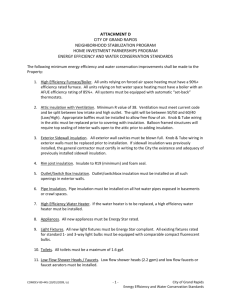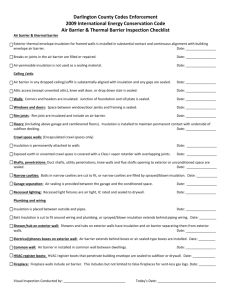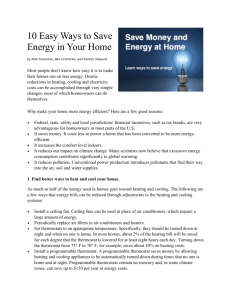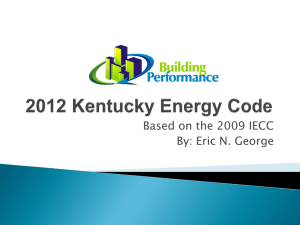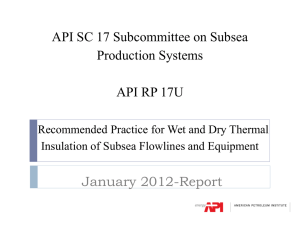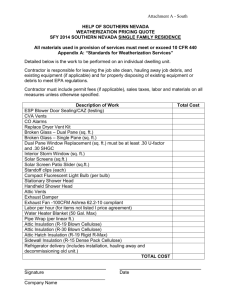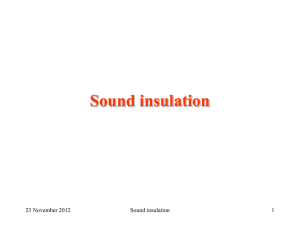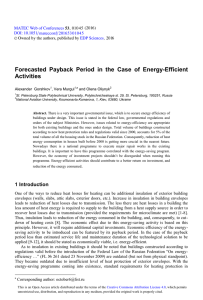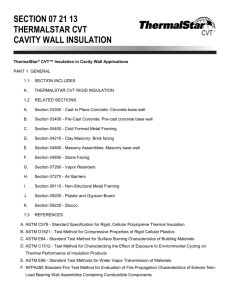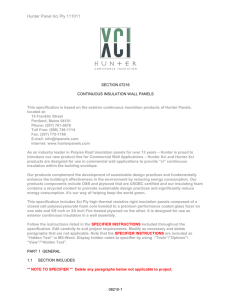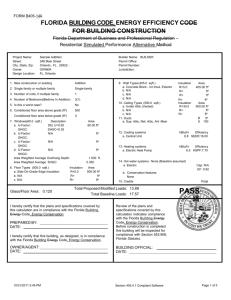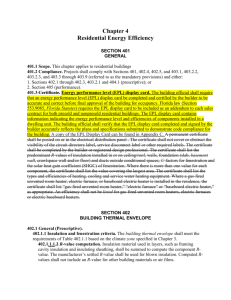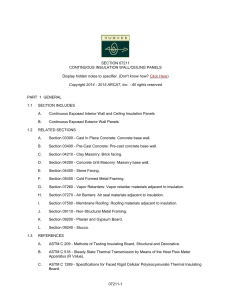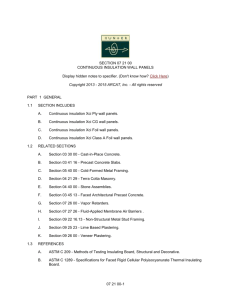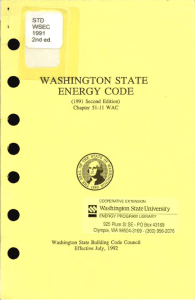Energy Efficiency Materials (Word template)
advertisement
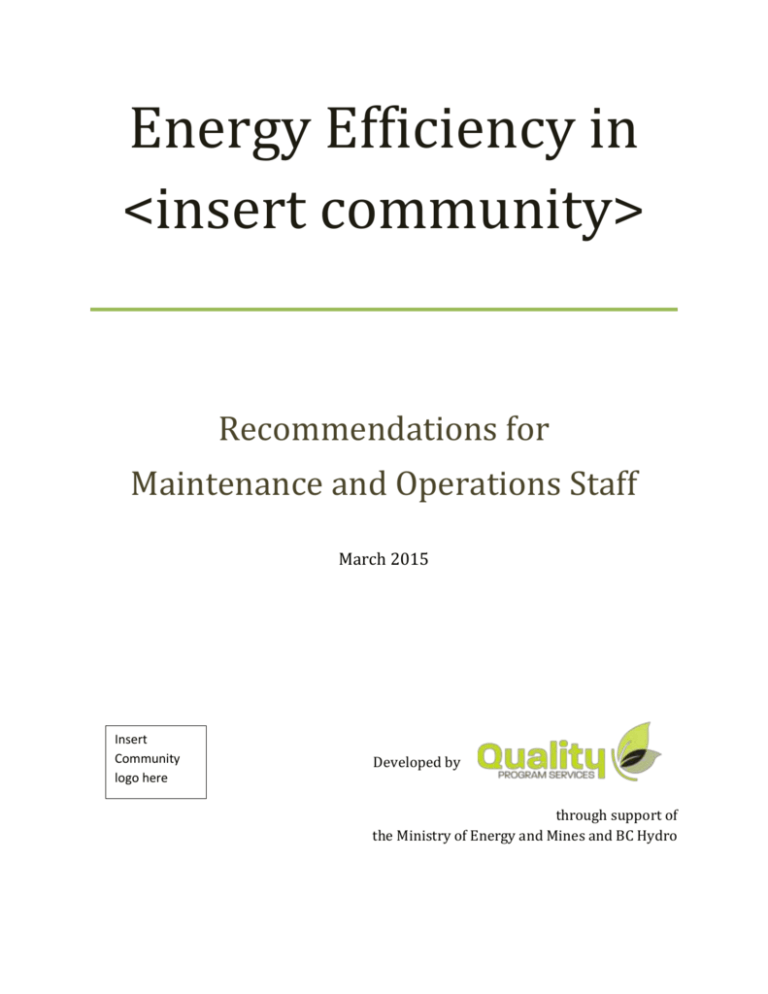
Energy Efficiency in <insert community> Recommendations for Maintenance and Operations Staff March 2015 Insert Community logo here Developed by through support of the Ministry of Energy and Mines and BC Hydro These charts and checklists can assist you in carrying out and prioritizing maintenance activities, and to develop new construction standards as part of an energy efficiency program in your community. They are intended to supplement the interactive energy efficiency workshop, which details your community’s energy situation. Factors Affecting Energy Consumption Energy efficiency is generally affected by three main factors: the quality of home construction and materials at the beginning, the frequency and extent of good maintenance practices, and how residents use the home and its components. Each is important for consideration in developing an energy program, and the extent to which each is applicable may be different depending on your current situation. March 2015 Where Energy Dollars Go The following breakdown shows where most energy dollars are spent. By far, the largest amount is spent on heating, of both your home and water. Therefore, in developing a priority of actions within your community, you may want to focus initial efforts on improving air sealing, increasing insulation, and upgrading to better heating systems (e.g., installing efficient wood/electric furnaces that capitalize on using wood with the benefit of having backup heat when residents are not home). March 2015 Home Energy Maintenance Checklist Heating Caulk and weather-strip doors and windows. Caulk and seal leaks where plumbing, ducting, or electrical wiring penetrates through exterior walls, floors, and ceilings. Use an inexpensive door sweep to reduce air leakage under exterior doors. Seal small holes around water pipes and stuff insulation into larger holes around plumbing fixtures. Use foam gaskets that fit behind cover plates to reduce heat loss around light switches and electrical outlets. Seal all joints in sheet metal ducts in a forced air furnace with mastic or other appropriate tape. Insulate ducts passing through unheated spaces. Install insulating gaskets behind electrical outlets and switch plates on exterior walls. Upgrade ceiling insulation to R-40 (higher R values mean greater insulation levels and thus more energy savings). Insulate exterior heated basement walls to at least R-20. Insulate floors over unheated areas to R-20. Install storm windows over single pane windows or use plastic film window kits. Replace an aging furnace with an efficient model, preferably one with an Energy Star® label. Replace single pane windows with energy efficient double pane windows mounted in nonconducting window frames. Install temperature controls on all space heat appliances. Hot Water Repair leaky faucets. Add an insulating wrap to an older water heater; for a new water heater check your manual to see if this is recommended. Install high efficiency low-flow showerheads. Replace your water heater, when needed, with an efficient Energy Star® model. Appliances Choose a refrigerator/freezer with automatic moisture control. Purchase Energy Star® appliances. Lighting Install CFL or LED bulbs in the fixtures that receive high use. Control outdoor lights with sensors or timers so they stay off during the day. March 2015 Maintenance Impacts on Home Comfort and Safety Make a list of what you expect from a house. Here’s a start: Keep the wet out Take moisture out Keep the wind out Stop drafts in the winter Allow gentle breezes in the summer Keep dust out Keep animals and insects out Allow residents to easily come in and out Keep the sun out Keep the heat in Keep us comfortable Keep us warm in the winter Keep us cool in the summer Keep our energy bills low Keep the noise out Keep the music in Give us privacy Store our possessions To be free from hazards and dangers To be aesthetically pleasing Low maintenance costs Long life Add your own: Consider the impact of doing specific maintenance on a home. Example: A cable is routed from downstairs to an upstairs room along the outside of the house. Holes are drilled in the building envelope to create access for the cable. Penetrations are not sealed. Negative impacts of doing this maintenance without sealing: Keep the wet out Take moisture out Keep the wind out Stop drafts in the winter Allow gentle breezes in the summer Keep dust out Keep animals and insects out Allow residents to easily come in and out Keep the sun out Keep the heat in Keep us comfortable March 2015 Keep us warm in the winter Keep us cool in the summer Keep our energy bills low Keep the noise out Keep the music in Give us privacy Store our possessions To be free from hazards and dangers To be aesthetically pleasing Low maintenance costs Long life Consider the impact of not doing specific maintenance on the homes. Example: A gas furnace is not regularly serviced. Negative impacts of not doing this maintenance: Keep the wet out Take moisture out Keep the wind out Stop drafts in the winter Allow gentle breezes in the summer Keep dust out Keep animals and insects out Allow residents to easily come in and out Keep the sun out Keep the heat in Keep us comfortable Keep us warm in the winter Keep us cool in the summer Keep our energy bills low Keep the noise out Keep the music in Give us privacy Store our possessions To be free from hazards and dangers To be aesthetically pleasing Low maintenance costs Long life Example: Windows and doors are not properly installed and sealed. Negative impacts of doing this maintenance improperly: Keep the wet out Take moisture out Keep the wind out Stop drafts in the winter Allow gentle breezes in the summer Keep dust out Keep animals and insects out Allow residents to easily come in and out Keep the sun out Keep the heat in Keep us comfortable March 2015 Keep us warm in the winter Keep us cool in the summer Keep our energy bills low Keep the noise out Keep the music in Give us privacy Store our possessions To be free from hazards and dangers To be aesthetically pleasing Low maintenance costs Long life New Construction Insulation and Air Seal Checklist* Insulation /Air Seal Detail Insulation Continuity Air Barrier Continuity Interior pony wall at a basement Rim joist Interior wall penetrating an exterior wall Insulated floor above garage Electrical penetration Electric panel set into an exterior wall Duct penetrating at a wall Wall behind shower/tub Wall behind fireplace Staircase walls Plumbing stack in an exterior wall Wall adjoining porch roof Door frame connection to a wall Attic knee walls Skylight shaft walls Attic access panel / stair Dropped ceiling/soffit Recessed lighting fixtures Cantilevered/floors over unheated spaces Steel/Masonry chimney penetrating an attic Part wall at an exterior wall and attic Plumbing stack at an attic penetration Tapered insulation at the attic edge Slab-edge Insulation Large beam set into a wall Attic/garage framing running alongside an exterior insulated wall Window and door and skylight rough opening Concrete in ICF penetrations Joints in air barrier *Explanation and graphics of air sealing details can be found in the Illustrated Guide to Energy Efficiency Requirements for Houses in BC included on the USB provided. Please refer to your correct region for more information. March 2015 Building Construction Standard Comparison Current BC Building Code Energuide 80 R-2000 Energy Star® Requirements Insulation, space and water heating equipment designed and installed in accordance with 9.36 of the BC Building Code Use energy efficient windows, heat recovery ventilation or improved insulation to meet energy target High efficiency space and water heating appliances Heat recovery ventilation required Mandatory air tightness levels Increased insulation of building enclosure to meet Energuide 80 performance level Costs Standard Additional $8,000 - $12,000 (or higher) per house Potential Energy Savings Benefits Baseline Varies Additional $8000 - $12,000 (or higher) per house 20% Use Energy Star® windows Use Energy Star® appliances Heat recovery ventilation required Increased insulation of building enclosure above code minimum Mandatory air tightness levels High efficiency space and water heating appliances Additional $10,000 - $15,000 (or higher) per house 20% Cost effective house and construction cost Reduced operating costs Improved indoor air quality Reduced noise Improved humidity control Unquantified higher operating costs reflecting lower air sealing and other construction standards Higher initial cost Investment in additional training for maintenance persons on new components Drawbacks March 2015 Reduced operating costs Improved indoor air quality Reduced noise Improved humidity control Built by certified R2000 contractor Higher initial cost Investment in additional training for maintenance persons on new components Reduced operating costs Improved indoor air quality Reduced noise Improved humidity control Higher initial cost Investment in additional training for maintenance persons for new components The BC Building Code has recently adopted new requirements for energy efficiency of new homes. These requirements and the building code reference are summarized below. Requirement Insulate ceilings, walls, and floors BC Building Code Reference* Table 9.36.2.6.A and Table 9.36.2.6.B. for the correct climate zone. Use energy efficient windows, door and Table 9.36.2.7 A, B and C for the skylights correct climate zone. Insulate foundations and assemblies in contact Table 9.36.2.8.A or B for the correct with the ground climate zone. Ducts located in the attic or garage are sealed 9.36.3.2. and insulated. Dampers are installed at air inlets and 9.36.3.3. exhausts. Heating equipment is located within the house 9.36.3.5. Temperature controls are installed on heating 9.36.3.6. and cooling equipment. Space heating and domestic hot water Tables 9.36.3.10. and 9.36.4.2. appliance meet efficiency requirements. Service water heating pipes are insulated at 9.36.4.4. the inlet and outlet of storage tanks. Water heaters have temperature controls. 9.36.4.5. The air barrier details, materials and locations 9.36.2.9., 9.36.2.10 have been identified. *A copy of the Illustrated Guide to Energy Efficiency Requirements for Houses in BC (a supplement to the BC Building Code Standards) is included on the USB provided. Please refer to your correct region for more information. Did you know? March 2015 Policy Development Policy development process A holistic Housing Policy, including energy efficiency requirements, represents the ‘tip of the iceberg’ in terms of the larger management and housing structure in a community. The following pyramid highlights a logical series of steps and considerations that can be followed to build a solid foundation for policy development. March 2015



